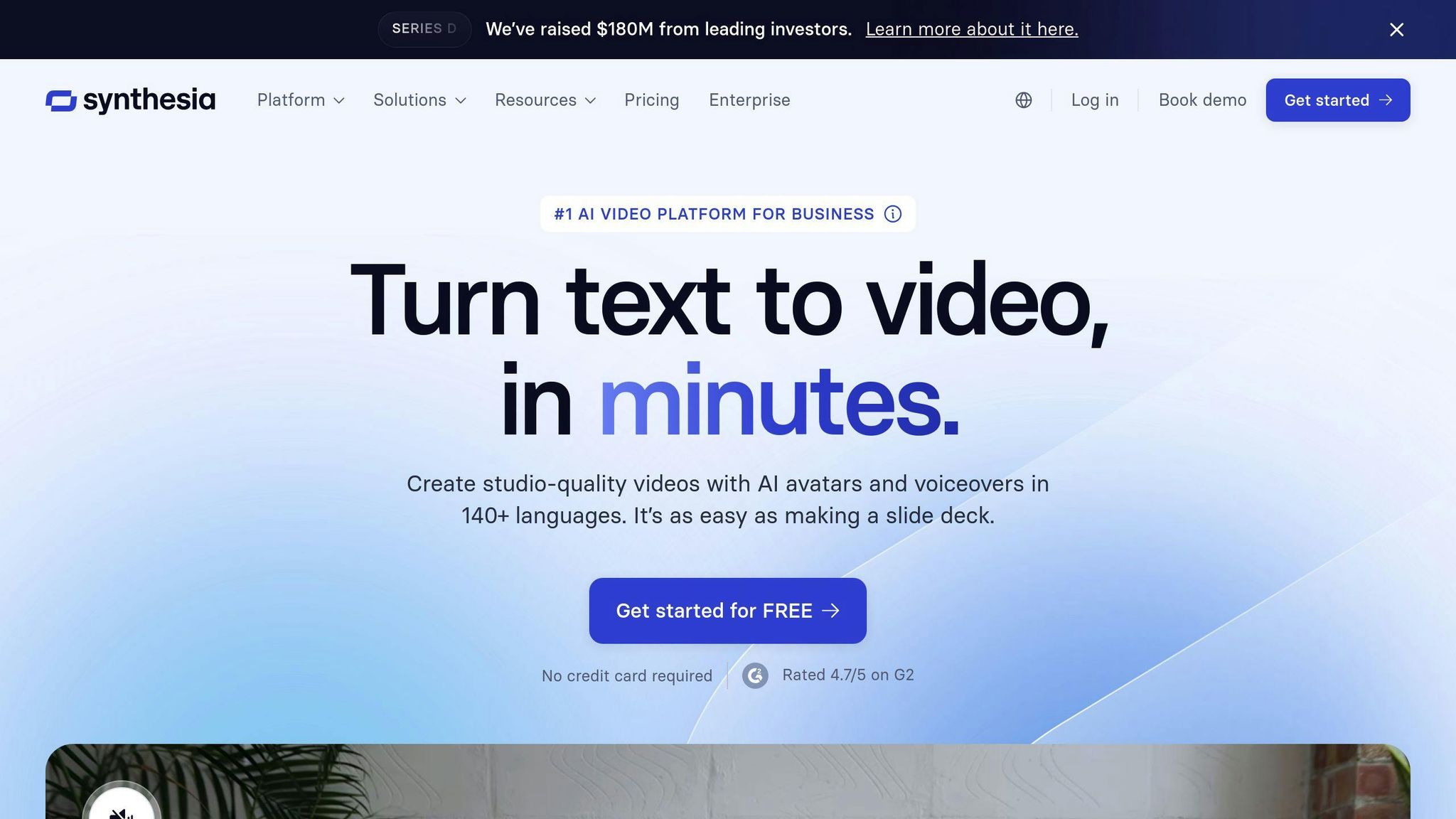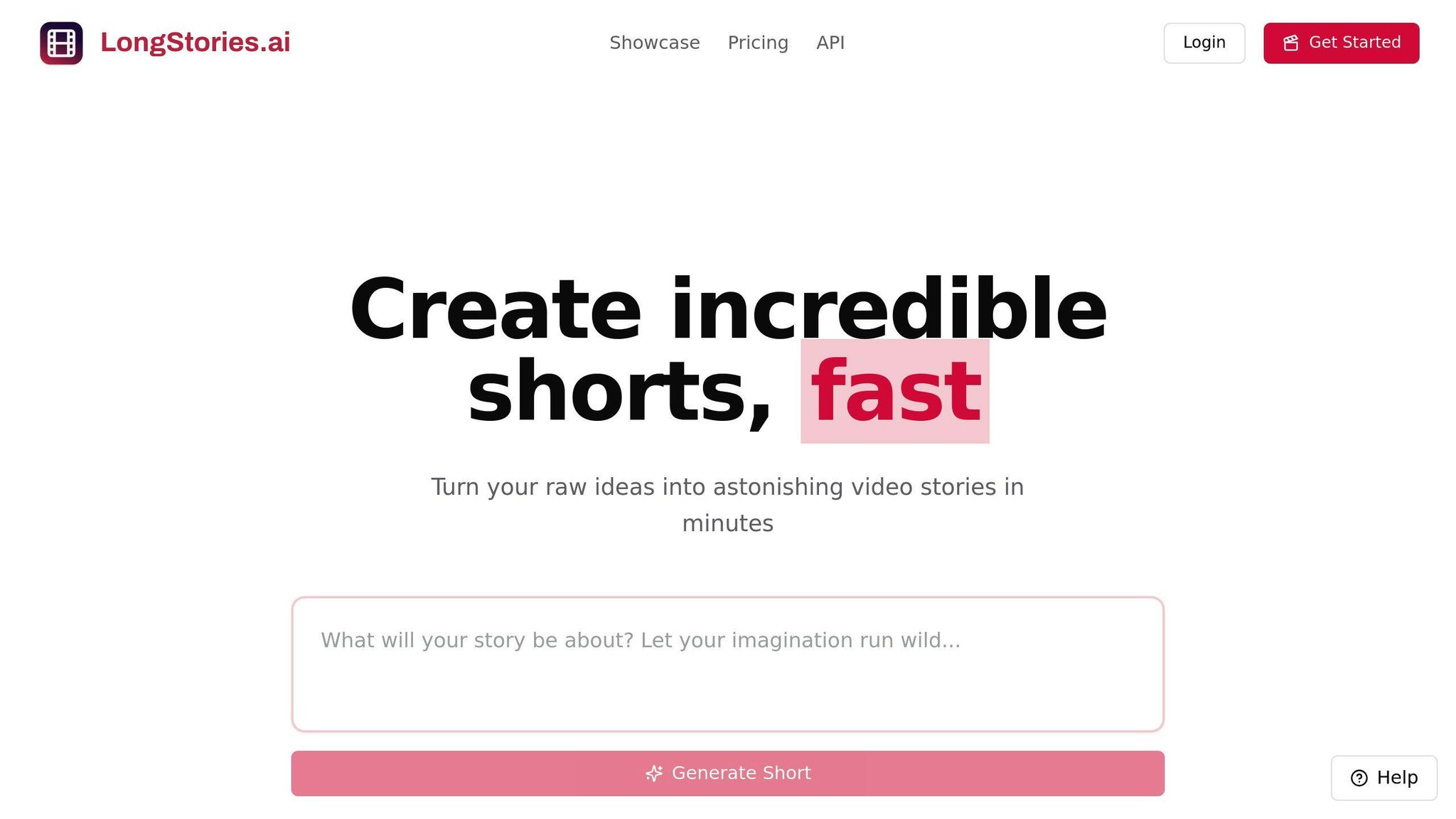
LongStories is constantly evolving as it finds its product-market fit. Features, pricing, and offerings are continuously being refined and updated. The information in this blog post reflects our understanding at the time of writing. Please always check LongStories.ai for the latest information about our products, features, and pricing, or contact us directly for the most current details.
Creating Marketing Videos with AI: Step-by-Step Tutorial
AI tools make video creation faster, cheaper, and easier. Here's what you need to know:
-
Why Use AI for Videos?
AI reduces production time from weeks to hours, lowers costs, and requires only basic computer skills. It's perfect for small businesses, content creators, and global brands needing videos in multiple languages. -
Best AI Video Tools:
Platforms like Synthesia, Pictory, and LongStories.ai offer features like AI avatars, text-to-video, and branded templates. -
How to Create AI Videos:
- Define your goals and audience.
- Write a clear script (use AI tools if needed).
- Choose visuals and audio.
- Use AI tools to assemble and edit.
- Review and finalize.
-
Improve Quality:
Add captions, maintain brand standards, and use data insights to refine content.
Quick Comparison of Top AI Video Tools:
| Platform | Key Features | Primary Use Case |
|---|---|---|
| Synthesia | 140+ AI avatars, 120+ languages | Corporate training & presentations |
| Pictory | Auto-editing, text-to-video | Social media & content repurposing |
| LongStories.ai | Custom templates, API access | Educational & marketing content |
AI video creation is a game-changer for marketers. Start small, focus on quality, and track performance to maximize results.
Create an AI Video in 4 Minutes with Synthesia

How to Select an AI Video Platform
Choosing an AI video platform involves assessing your needs, technical requirements, and budget. Here's what you should know to make an informed decision.
Top AI Video Creation Tools
| Platform | Key Features | Primary Use Case |
|---|---|---|
| Synthesia | 140+ AI avatars, 120+ languages | Corporate training & presentations |
| Pictory | Auto-editing, text-to-video | Social media & content repurposing |
| LongStories.ai | Custom templates, API access | Educational & marketing content |
These tools offer a range of features, but the right choice depends on your specific priorities.
Key Selection Criteria
When comparing AI video platforms, focus on these critical factors:
-
Technical Capabilities & Ease of Use
Look for quality AI avatars, text-to-speech options, and a user-friendly interface. A confusing tool can drive users away - 63% of users abandon overly complex platforms. -
Content Library Access
Check for a wide variety of stock footage, music options, and templates. Diverse avatar choices can also be a big plus. -
Budget and Scalability
Review pricing tiers to ensure key features are included. Also, consider if the platform can grow with your needs and supports automation through API access.
LongStories.ai Platform Review

LongStories.ai stands out as a platform that tackles common challenges faced by marketers:
| Feature Category | Benefits |
|---|---|
| Content Creation | Ideal for educational videos, explainers, and marketing content |
| Customization | Offers branded templates, voice options, and watermark-free videos |
| Scalability | Flexible plans suitable for both small teams and enterprise needs |
"AI-powered video generators simplify complex processes", according to industry experts. This makes platforms like LongStories.ai an attractive choice for marketing teams.
With 52% of marketers citing video content as delivering the highest ROI, it's clear that picking the right platform can have a big impact on your results.
5 Steps to Make AI Marketing Videos
Creating marketing videos with AI is easier than ever. Here's a simple guide to help you produce engaging video content using AI tools.
Step 1: Define Your Goals and Audience
Start by outlining what you want your video to achieve. Are you aiming to boost brand awareness, drive sales, or educate your audience? Identify your target viewers, the actions you want them to take, and the best platforms to reach them. Clear goals will guide the entire process, from scripting to distribution.
Step 2: Write a Strong Script
A well-crafted script is essential for a successful video. AI tools like Creatify.ai can help you create engaging scripts that hold your audience's attention. Break your script into three parts: a 15-20 second hook to grab attention, a 1-2 minute main message, and a 10-15 second call to action that encourages viewers to act.
Step 3: Choose the Right Media
Select visuals and audio that align with your message. Platforms like Synthesia offer libraries with over 230 AI avatars and customization options. Use high-quality visuals, brand-aligned elements, and professional AI-generated voice-overs to keep your video polished and engaging.
Step 4: Create and Edit with AI
AI tools make video production straightforward. With platforms like HeyGen, you can easily assemble your video. During editing, focus on:
- Syncing audio and video seamlessly
- Adding smooth transitions between scenes
- Including captions for better accessibility
- Incorporating your brand’s colors, fonts, and logos
Step 5: Review and Finalize
Before publishing, review your video to ensure everything is on point. Check for smooth synchronization, clear messaging, consistent branding, and accessibility features. Tools like Pictory can help you run automated quality checks and predict audience engagement. This step ensures your video meets your goals and resonates with your viewers.
Once polished, your video is ready to represent your brand and connect with your audience effectively.
sbb-itb-94859ad
How to Improve AI Video Quality
Maintain Brand Standards
To keep your videos aligned with your brand, use AI platforms that offer brand asset management tools. For example, Visla provides features specifically designed to store and apply brand elements consistently across projects.
Key elements to consider include:
- Color schemes that match your style guide
- Consistent typography and font pairings
- Proper logo placement and sizing
- AI voice-overs that match your brand's tone and style
Pro tip: Create a brand preset in your AI tool. This saves time and ensures your videos stay consistent from project to project.
Once your branding is locked in, the next step is to focus on keeping your audience engaged.
Boost Video Engagement
Did you know personalized videos can increase engagement by 20% and conversions by 15%? (Maverick).
Here’s how to make your videos more interactive and tailored to your audience:
- Add AI-powered quizzes, polls, or clickable calls-to-action to encourage interaction and collect feedback.
- Use AI avatars customized to match your audience's demographics.
- Create region-specific versions of your videos and adjust content based on viewer data for better cultural relevance.
While engagement is crucial, making your videos accessible ensures they can reach everyone.
Add Accessibility Features
Accessibility is a must if you want your videos to connect with a broader audience. Wistia's 2022 research found that videos with captions have 80% higher completion rates than those without.
| Feature | Implementation & Impact |
|---|---|
| Captions | Use AI tools like Pictory for automated captions; helps improve comprehension and retention. |
| Audio Descriptions | Add AI-generated voice descriptions for visuals; makes content accessible for visually impaired viewers. |
| High Contrast Elements | Ensure text overlays meet WCAG standards; improves readability for all users. |
Final Check: Before hitting publish, use AI analysis tools to confirm all accessibility features are functioning properly. Platforms like Synthesia include built-in accessibility checkers to help you meet universal design standards.
Track and Improve Video Results
Monitor Video Metrics
Keeping an eye on the right metrics is key to understanding how your videos are performing. Here's a quick breakdown of what to track and why it matters:
| Metric Type | What to Track | Why It Matters |
|---|---|---|
| Engagement | Watch time, completion rate, likes, shares | Indicates how well your content connects with viewers |
| Performance | Click-through rate (CTR), conversion rate | Evaluates how effective your video is at driving actions |
| Technical | Load time, buffering rate | Helps identify any delivery or playback issues |
Pro tip: Focus on metrics that lead to actionable insights. For example, a video with a million views is great, but if it doesn't drive conversions or engagement, it’s not helping your goals.
Once you’ve identified the metrics that matter most, you can use AI tools to fine-tune your content and achieve better results.
Use AI Data for Better Videos
AI tools can transform raw data into insights you can act on. For instance, Creatify.ai offers real-time analytics to help marketers tweak their content during the creation process. This means you can make adjustments immediately based on how viewers interact with your videos.
"AI video generators are not just about automating video creation; they're about leveraging data to create content that resonates with your audience." - Victor Riparbelli, CEO of Synthesia
According to Synthesia, 61% of marketers believe AI-generated content will play a major role in marketing strategies within the next two years. Here’s how you can use AI insights to improve your videos:
- Track engagement patterns: Identify where viewers lose interest or drop off.
- Experiment with scripts and lengths: Test different versions to see what works best.
- Refine calls-to-action (CTAs): Adjust placement and design for better results.
- Analyze platform-specific behavior: Understand how viewers interact with your videos across various channels.
To get the most out of your efforts, link your video analytics to your existing marketing tools. Integrating video data with CRM systems or marketing automation platforms can give you a full view of how videos influence your audience at every stage of their journey.
Important: Always respect viewer privacy and follow data protection regulations.
Conclusion: Next Steps with AI Videos
Now that you’ve got the basics of creating marketing videos with AI, it’s time to put that knowledge into action. AI video creation is becoming a key part of marketing strategies, so having a clear plan is crucial.
Here’s a simple roadmap to help you kick things off:
| Phase | Action Items | Expected Timeline |
|---|---|---|
| Platform Selection & Testing | Pick a platform and create 2–3 test videos to check its features | 2–3 weeks |
| Full Implementation | Set up a content calendar and establish a workflow | 1 month |
Start Small
Begin with simple projects, like product demos or short social media clips. Many platforms offer free trials, so you can experiment without spending much. Once you’ve gained confidence with smaller tasks, you can explore more advanced features and projects.
Master the Platform
Learn the tools and features that align with your goals. Knowing the platform inside and out is essential, but don’t stop there. Make sure your videos consistently meet high-quality standards to keep your audience engaged.
Keep Quality at the Core
As you scale up, focus on these three key areas to maintain quality:
- Brand Consistency: Make sure every video reflects your brand’s voice and style.
- Technical Quality: Test videos on different platforms and devices for smooth playback.
- Audience Engagement: Use AI-driven analytics to fine-tune your content strategy based on what resonates.
Budget Wisely
While free options are great for testing, professional features often range from $18 to $29 per month. Plan your budget based on your production goals and the return you expect.
Stay Ahead of the Curve
To keep your strategy competitive, stay updated on AI advancements. Collect viewer feedback to guide future content and be ready to adapt as new AI capabilities emerge. This approach will ensure your video marketing stays effective in the long run.
FAQs
How to make simulation videos using AI?
Simulation videos are a great way to explain products, train teams, or demonstrate processes visually. With AI tools, creating these videos has never been easier or faster.
Here’s how you can create your own simulation videos:
- Plan Your Script: Start by crafting a clear, concise script. A strong script ensures your video stays focused and impactful. Refer to tips in the "Write a Strong Script" section for guidance.
- Pick an AI Avatar: Choose an avatar from platforms like Synthesia that aligns with your brand and fits the context of your simulation.
- Add and Edit Content: Upload your script to the platform, select a voice that matches your brand's tone, and use editing tools to fine-tune the video. Make sure the steps in your simulation are easy to follow and visually clear.
- Create the Video: Once everything is set, let the platform generate your video. Most tools can produce the final version in minutes.
Some popular platforms for AI simulation videos include Synthesia, FlexClip, and Elai. Many of these tools offer free plans so you can test their features before committing.
Tips for Better Simulation Videos:
- Keep scenarios logical and easy to follow.
- Make sure the pacing is consistent so viewers can absorb the information.
- Prioritize visual clarity to simplify complex ideas.
